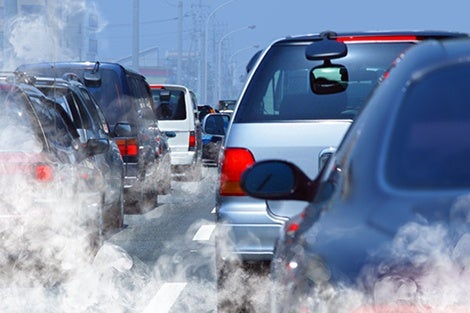For immediate release: Wednesday, June 28, 2017
Boston, MA – A new study of 60 million Americans—about 97% of people age 65 and older in the United States—shows that long-term exposure to airborne fine particulate matter (PM2.5) and ozone increases the risk of premature death, even when that exposure is at levels below the National Ambient Air Quality Standards (NAAQS) currently established by the U.S. Environmental Protection Agency.
The Harvard T.H. Chan School of Public Health researchers found that men, blacks, and low-income populations had higher risk estimates from PM2.5 exposure compared with the national average, with blacks having mortality risks three times higher than the national average.
The results showed that if the level of PM2.5 could be lowered by just 1 microgram per cubic meter (ug/m3) nationwide, about 12,000 lives could be saved every year. Similarly, if the level of ozone could be lowered by just 1 part per billion (ppb) nationwide, about 1,900 lives would be saved each year.
The study appears in the June 29, 2017 issue of the New England Journal of Medicine. Watch a NEJM video of the authors discussing the study and an animation.
“This is a study of unprecedented statistical power because of the massive size of the study population. These findings suggest that lowering the NAAQS for fine particulate matter will produce important public health benefits, especially among self-identified racial minorities and people with low incomes,” said Francesca Dominici, principal investigator of this study and professor of biostatistics at Harvard Chan School and co-director of the Harvard Data Science Initiative.
The researchers examined Medicare claims records of 60 million Americans 65+ over a seven-year period, representing 460 million person-years of follow-up. They also estimated air pollution levels at each 1 kilometer grid for the entire U.S. upon which the claims data could be overlaid and interpreted.
To do this, the Harvard Chan researchers leveraged the results of an exposure prediction model developed by doctoral student Qian Di and Joel Schwartz, professor of environmental epidemiology and the study’s senior author. The exposure prediction model leverages satellite-based measurements and a computer simulation of air pollution.
By relying on this well-validated prediction model, the team was able to include subjects who live in unmonitored and less-populated areas so that the effects of air pollution on all 60 million people could be analyzed regardless of whether they lived in urban, suburban, or rural areas.
“This study shows that although we think air quality in the United States is good enough to protect our citizens, in fact we need to lower pollution levels even further,” said Schwartz.
Other Harvard Chan authors include Yan Wang, Antonella Zanobetti, Yun Wang, Petros Koutrakis, and Christine Choirat.
Support for the study came from grants from the Health Effects Institute (4953-RFA14-3/16-4), National Institute of Environmental Health Sciences, part of the National Institutes of Health (R01 ES024332-01A1, ES-000002, ES024012, R01ES026217), National Cancer Institute (R35CA197449), and Environmental Protection Agency (83587201-0, RD-83479801).
“Air Pollution and Mortality in the Entire Medicare Population,” Qian Di, Yan Wang, Antonella Zanobetti, Yun Wang, Petros Koutrakis, Christine Choirat, Francesca Dominici, Joel D. Schwartz, New England Journal of Medicine, June 29, 2017, doi: 10.1056/NEJMoa1702747
For more information:
Todd Datz
tdatz@hsph.harvard.edu
617.432.8413
photo: iStockphoto.com
Visit the Harvard Chan School website for the latest news, press releases, and multimedia offerings.
###
Harvard T.H. Chan School of Public Health brings together dedicated experts from many disciplines to educate new generations of global health leaders and produce powerful ideas that improve the lives and health of people everywhere. As a community of leading scientists, educators, and students, we work together to take innovative ideas from the laboratory to people’s lives—not only making scientific breakthroughs, but also working to change individual behaviors, public policies, and health care practices. Each year, more than 400 faculty members at Harvard Chan School teach 1,000-plus full-time students from around the world and train thousands more through online and executive education courses. Founded in 1913 as the Harvard-MIT School of Health Officers, the School is recognized as America’s oldest professional training program in public health.
